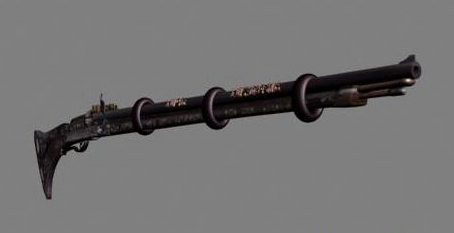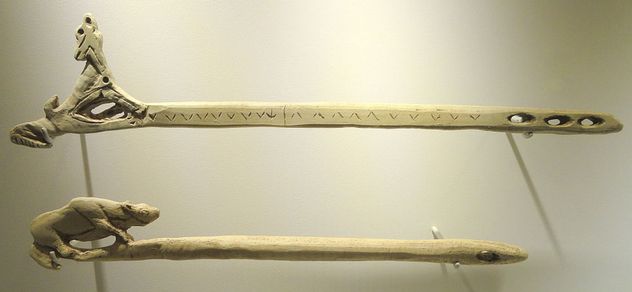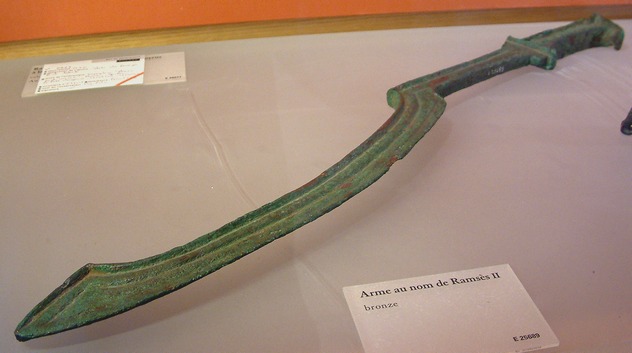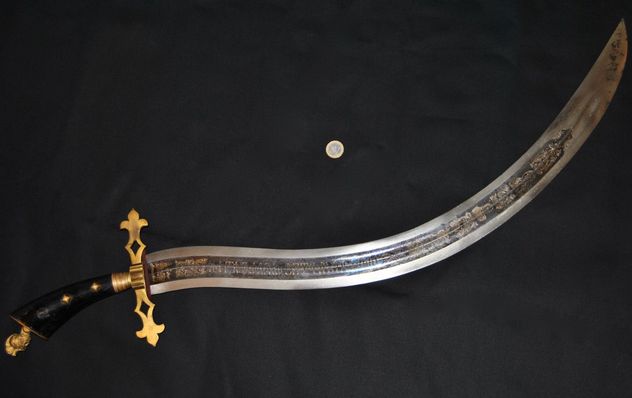5.火槍
Developed in ancient China, the fire lance was a spear-like weapon that fired a projectile with gunpowder. The earliest form was a simple bamboo tube packed with sand that was strapped to a spear. Such a weapon would have been able to blind an enemy and give the wielder the advantage in close quarters combat. As technology evolved, though, fire lances started to incorporate shrapnel and poison darts. But explosions strong enough to launch these projectiles required stronger housings, and fire lances began to be made first of a strong type of paper and then finally metal.
火槍發(fā)明于古代中國(guó),它類似于長(zhǎng)矛又可以發(fā)射火藥槍彈。它最早的形式是:把裝滿沙子的竹筒綁在一個(gè)長(zhǎng)矛上,這樣,就可以弄瞎敵人的眼睛,在近距離搏斗中取得優(yōu)勢(shì)。隨著科技的發(fā)展,火槍逐漸包含了彈片和毒鏢,但是要想得到足夠強(qiáng)大的爆炸力,火槍就必須的具備一個(gè)堅(jiān)硬的外殼,初始時(shí),火槍的外殼是由一種堅(jiān)硬的紙制作的,后來變成金屬制作了。

Accounts also describe a weapon called a “fire-tube” being used as a flamethrower to shower enemies with flames that were 3.5 meters (12 ft) tall. Further developments led to poisonous chemicals being mixed with the explosive mixture, which would cause the unfortunate victim’s burns to go septic. Less of an explosion and more of a steady stream of flame, weapons like these would belch “poisonous fire” for an estimated five minutes before burning out.
文獻(xiàn)中還描述了一種名叫“火管”(fire-tube)的武器,它被用作火焰噴射器,可以給3.5米(12英尺)高的敵人帶來一場(chǎng)“火浴”。后來它發(fā)展成為把有毒的化學(xué)物與爆炸物相混合的武器,這時(shí),它爆炸后釋放的腐蝕物能夠造成無辜者的傷亡。這樣的武器其爆炸規(guī)模更小但是火焰源源不斷,它會(huì)釋放大約五分鐘的有毒氣體。直到爆炸物完全燃盡。
4.梭鏢投射器

A Stone Age dart weapon, the atlatl was the precursor to the bow and arrow. While spears could only be thrown at limited speeds and distances, atlatl could launch darts at over 160 kilometers per hour (100 mph). It was a deceptively simple weapon, nothing more than a handheld stick with a protrusion or notch at one end where a dart could be set. Yet despite their simplicity, atlatl were so effective that it’s even been theorized that they contributed to the extinction of the woolly mammoth they were used to hunt.
梭鏢投射器是石器時(shí)代的投擲武器,是弓和箭的前身。長(zhǎng)矛只能以有限的速度拋出較短的距離,而梭鏢投射器能以每小時(shí)160千米(100英里每小時(shí))的速度向前拋出。這是一個(gè)看似簡(jiǎn)單的武器,就是一個(gè)在末端具有突起或缺口(可以設(shè)置飛鏢)的手持棍子,盡管其設(shè)計(jì)非常簡(jiǎn)單,但卻非常有效,以至于有理論認(rèn)為正因?yàn)槿藗冇盟鼇聿稓⒚歪锵螅罱K導(dǎo)致了猛犸象的滅絕。
The weapon’s speed came from its flexibility. Both the atlatl and the dart were made of flexible wood. The two parts bent simultaneously when the atlatl was fired, which allowed the energy stored in each to launch the dart at very high velocities. Archaeological evidence tells us that the use of the atlatl was also widespread, with examples found in every inhabited continent except Africa. Though they were eventually replaced with the easier-to-use bow and arrow, the atlatl stood the test of time, being used by the Aztecs even as late as the 1500s.
武器的速度取決于它的靈活性,atlatl 和飛鏢都是用柔韌的木頭制成。當(dāng)射擊時(shí),atlatl 和飛鏢同時(shí)彎曲。這樣一來,匯聚的能量將使飛鏢獲得極高的速度。考古發(fā)現(xiàn),atlatl 的使用相當(dāng)廣泛,除了非洲之外,每一個(gè)有人居住的大陸都發(fā)現(xiàn)了它曾廣泛被使用的證據(jù)。盡管其最終被更為方便的弓箭所代替,不過atlatl 的使用持續(xù)了很長(zhǎng)時(shí)間,甚至在16世紀(jì)時(shí)還被阿茲特克人作為武器使用。
3.鐮刀劍

Although sometimes called a sickle-sword, the ancient Egyptian khopesh was more of a cross between a sword and a battle ax. During earlier Egyptian times, the mace represented ruling power, but the khopesh‘s deadliness on the battlefield eventually made it the preferred status symbol of Egypt’s elite. Even Ramses II was depicted wielding one.
盡管有時(shí)被稱作鐮刀劍,khopesh作為古埃及的武器之一,不僅僅是戰(zhàn)斧和劍之間的過度物。在古埃及早期,權(quán)杖代表著執(zhí)政權(quán),但是khopesh在戰(zhàn)場(chǎng)上的致命性最終使得其被看作古埃及上層精英的象征。甚至拉美西斯二世都被描繪使用過khopesh。
A Bronze Age weapon, the khopesh was usually cast out of a single piece of bronze and could be quite heavy. It’s believed to have been an Egyptian adaptation of a large, two-handed weapon similar to a war ax, imported from Canaan and Mesopotamia. The blade had a pronounced curve, like a sickle, though only the outside edge was sharpened. Much like the battle ax, the khopesh could be used as a hacking weapon, though its shape also made it efficient at slashing. The inner part of the curve was equally functional and could trap an arm or yank away an opponent’s shield. Some had small snares for that very purpose.
作為青銅時(shí)代的武器,khopesh由銅塊鑄造而成,但卻具有一定重量。它被認(rèn)為是與戰(zhàn)斧相似的雙手武器,從迦南和美索不達(dá)米亞進(jìn)口。刀刃有明顯的弧度,就像一把鐮刀,只有外部邊緣被磨得鋒利。與戰(zhàn)斧相似,khopesh可以當(dāng)作劈砍武器來使用。它的外形使其在劈砍上也十分高效。khopesh弧度的內(nèi)側(cè)部分也具有實(shí)際功能,能夠用來制止敵人的武器,還能猛拉敵人的護(hù)罩。
2.Shotel

Unlike the khopesh, the shotel was a true sickle-sword once used in ancient Ethiopia. Its shape made it extremely difficult to block with another sword or even a shield—shotel would just curve around it to puncture the defender. Despite that and its vicious appearance, it was almost universally considered useless.
與khopesh所不同,shotel曾經(jīng)確實(shí)被古埃塞爾比亞人當(dāng)做鐮刀劍使用。它的外形使其很難與其他刀劍或者護(hù)罩進(jìn)行格擋。不考慮它的外觀,shotel被普遍認(rèn)為不實(shí)用。
The hilt was too small for a large, scythe-shaped blade, which made it an unwieldy weapon to hold or aim properly. Fighting with a shotel proved quite difficult. Because of the shape of the blade, even drawing it from its scabbard was somewhat awkward. Scabbards stretched a foot longer than the swords themselves and were worn pointing behind the owner, which meant drawing it with the blade facing the correct way required a large bend of the wrist. European accounts of the weapon were extremely negative, and even the Ethiopians themselves considered shotels little more than ornamental. They had a saying about the shotels that essentially deemed the weapons useful for nothing more than impressing women. We suppose some weapons were just meant for a different kind of battle.
與巨大的鐮刀形刀刃相比,它的手柄太小了些,這使得它不但顯得笨重,且難以瞄準(zhǔn)目標(biāo)。使用shotel作戰(zhàn)被證明非常之難。因?yàn)樗牡度械男螤睿瓦B想要將其從劍鞘里拔出都會(huì)很棘手。歐洲對(duì)于該武器的記載和評(píng)價(jià)都偏低,就連埃塞爾比亞正教會(huì)也說它只適合裝飾所用。也許該武器是為了別樣的戰(zhàn)爭(zhēng)而制造出來的吧。
1.劍鞭

Urumi were flexible sword whips. The blade itself was made of extremely bendable metal that, when not in use, could be wrapped around the waist like a belt. Blade lengths differed, but urumi could reach lengths of 3–5 meters (12–16 ft).
Urumi 是易彎曲的劍鞭,刃片是由彎曲度很高的金屬打造而成。不用時(shí),可像腰帶一樣纏在腰上。刃片長(zhǎng)短不一,Urumi能夠達(dá)到3-5米長(zhǎng)。
rumi were whipped in circles, creating a defensive zone difficult for an opponent to penetrate. With both sides of the blade sharpened, they were extremely dangerous even for the wielder and required years of training. Even simple things like stopping the weapon and changing directions were considered special skills difficult to master. Due to the unique fighting style, urumi could not be used in battle formations and were better suited for man-to-man combat and assassinations. Yet despite the stringent requirements for wielding one properly, they were an unstoppable force once mastered. Parrying proved almost useless against an urumi, because even if an opponent tried to stop it with a shield, the urumi would just bend around it to strike.
Urumi 可以彎成一個(gè)小圓圈,形成一個(gè)防御區(qū),敵人很難滲入進(jìn)來。Urumi 的每一面都很尖銳,即使針對(duì)訓(xùn)練多年的使用者來說也相當(dāng)危險(xiǎn)。哪怕是最簡(jiǎn)單的停住或者改變方向都需要具有高超技巧才能做到。由于獨(dú)特的戰(zhàn)斗風(fēng)格,Urumi 不適合用于戰(zhàn)斗隊(duì)形,只適用于兩個(gè)人之間的對(duì)決。
















